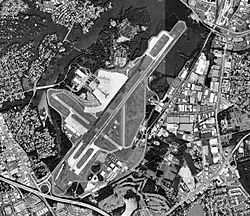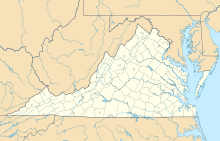Norfolk International Airport facts for kids
Quick facts for kids
Norfolk International Airport
|
|||||||||||||||
|---|---|---|---|---|---|---|---|---|---|---|---|---|---|---|---|

1990 USGS Photo
|
|||||||||||||||
| Summary | |||||||||||||||
| Airport type | Public | ||||||||||||||
| Owner | City of Norfolk | ||||||||||||||
| Operator | Norfolk Airport Authority | ||||||||||||||
| Serves | Norfolk, Virginia | ||||||||||||||
| Location | 2200 Norview Avenue Norfolk, Virginia (Physical Location Address) |
||||||||||||||
| Elevation AMSL | 26 ft / 8 m | ||||||||||||||
| Coordinates | 36°53′41″N 076°12′04″W / 36.89472°N 76.20111°W | ||||||||||||||
| Website | www.NorfolkAirport.com | ||||||||||||||
| Map | |||||||||||||||
| Runway | |||||||||||||||
|
|||||||||||||||
| Statistics (2009) | |||||||||||||||
|
|||||||||||||||
|
Source: Federal Aviation Administration
|
|||||||||||||||
Norfolk International Airport (airport codes: ORF, KORF) is a public airport located in Norfolk, Virginia. The City of Norfolk owns it, and the Norfolk Airport Authority runs it. This airport serves the Hampton Roads area in southeast Virginia. It also helps people in northeast North Carolina.
Norfolk International has about 80 flights leaving every day. These flights go to many big cities across the United States. It is the third-busiest airport in Virginia. It is also the 66th largest airport in the country based on how many people use it each year. In 2009, over 3.5 million people traveled through the airport. By June 2011, about 311,000 passengers used it.
The main airlines that fly from Norfolk International Airport are Southwest Airlines, US Airways, Delta Air Lines, and American Airlines.
Contents
History of the Airport
Commercial flights started in the Norfolk area around 1926. The Mitten Line, run by Philadelphia Rapid Transit Air Service, Inc., offered the first commercial flights. Norfolk International Airport was built in 1938. It first had a 3,500-foot (1,067 m) runway. The first airport building, called a terminal, was finished by 1940.
The Airport During World War II
During World War II, Norfolk Municipal Airport became very important. The United States Army Air Corps took control of the airport from 1942 to 1947. They made the runway longer and built two more runways. This was done to handle many more flights and bigger aircraft. The Norfolk Fighter Wing was formed in August 1942. Its job was to protect the Norfolk area from air attacks. After the Pearl Harbor attack in December 1941, the 52nd Fighter Group was stationed at the airport. Many different squadrons were at Norfolk Airport during the early years of the war. This ended in July 1944.
Growth After the War
The Army Air Corps gave the airport back to the city in late 1945. The number of commercial travelers grew quickly. Two new airlines started regular flights. In 1948, Piedmont Airlines began flying from Norfolk. That same year, work started on a larger, more modern terminal building.
In 1950, a new group called the Norfolk Port and Industrial Authority (NPIA) took over the airport. At that time, Norfolk Municipal Airport was one of the busiest in the nation. The new terminal opened in 1951.
Becoming a Regional Hub
In the 1960s, planes changed from propeller aircraft to jets. Norfolk Municipal Airport also changed by making its runways and taxiways longer and stronger. Because of these improvements, by 1968, the airport became the main air transportation center for the entire Hampton Roads area. Its name was changed to Norfolk Regional Airport. To prepare for big growth in the next 30 years, NPIA made a plan to expand the airport into the 21st century.
In 1974, the airport opened its newest terminal. More land was bought so the airport could get even bigger. In 1976, the airport's name changed again to Norfolk International Airport. New federal customs buildings were added. New buildings were also built for the fire station, maintenance depot, and ATC tower. One challenge the airport faced as it grew was solved by the nearby Botanical Garden. It created a green area between the airport and the city. This made Norfolk International Airport a national example of how to grow an airport while protecting nature.
Modernizing the Airport
The 1980s brought many changes. A new building for general aviation (private planes) opened. A new air cargo terminal was also built. More areas for parking were added. Even the name of the group running the airport changed in 1988. It went from Norfolk Port and Industrial Authority to Norfolk Airport Authority.
In the 1990s, the air cargo terminal and parking areas were made even bigger. In 1991, Norfolk International expanded its concourses. This added 10 more gates, bringing the total to 24 gates. A new fire station and a new FAA air traffic control tower were also built.
Airport Facilities and Aircraft
Norfolk International Airport covers an area of about 1,300 acres (5.3 km²). The airport has a main runway (5-23) which is 9,000 feet (2,743 m) long and 150 feet (46 m) wide. It also has a crosswind runway (14-32) which is 4,876 feet (1,486 m) long and 150 feet (46 m) wide. These runways allow almost all types of commercial aircraft to use the airport.
The airport plans to remove the crosswind runway. Instead, they will build a second runway that runs parallel to the main runway (5-23).
In 2006, the airport had 128,715 aircraft operations (takeoffs and landings). This averaged about 352 operations per day. The flights included 44% scheduled commercial flights, 33% general aviation (private flights), 16% air taxi (small charter flights), and 8% military flights. At that time, 106 aircraft were based at the airport. About half of these (51%) were single-engine planes. Of the rest, 30% had multiple engines, 17% were jet aircraft, and 2% were helicopters.
FAA Control Tower
The FAA Norfolk Air Traffic Control Tower was built in 1995. It is 134 feet (41 m) tall. The Federal Aviation Administration manages the Norfolk Tower. It handles about 1,100 aircraft movements each day.
Cargo Services
Norfolk International Airport (NIA) has one of the most modern and efficient air cargo facilities in the state of Virginia. About 70 million pounds (31.7 million kg) of air cargo are moved in and out of the Airport each year. Many companies that only move cargo use the airport. These include Airborne Express, FedEx, United Parcel Service, and the U.S. Postal Service. NIA's two air cargo terminals have 88,000 square feet (8,175 m²) of space. A nearby aircraft ramp allows planes to access the warehouses directly.
Passenger Services
Ground Transportation
There are no bus services directly to and from Norfolk International Airport. The closest bus stop is about 1.5 miles (2.4 km) away.
All ground transportation services are located in the arrivals terminal. Several rental car companies have offices in the terminal. Taxis are usually found at the main entrance.
Parking
A nine-floor long-term parking garage is located next to the arrivals terminal. It opened in July 2002. This garage has 2,800 parking spaces.
Images for kids
See also
 In Spanish: Aeropuerto Internacional de Norfolk para niños
In Spanish: Aeropuerto Internacional de Norfolk para niños









